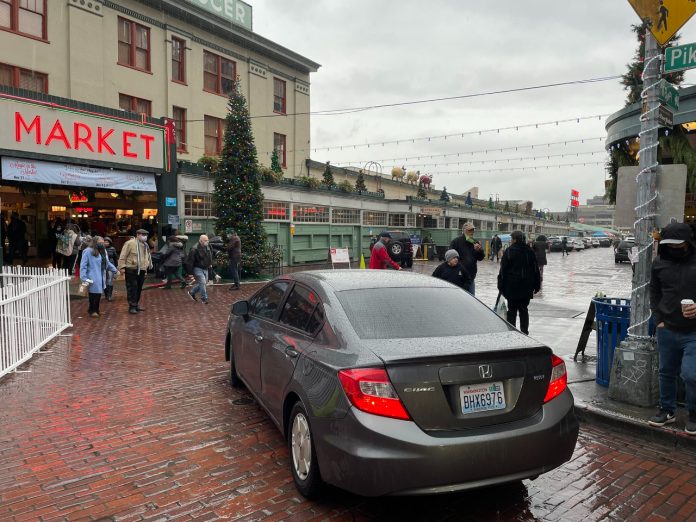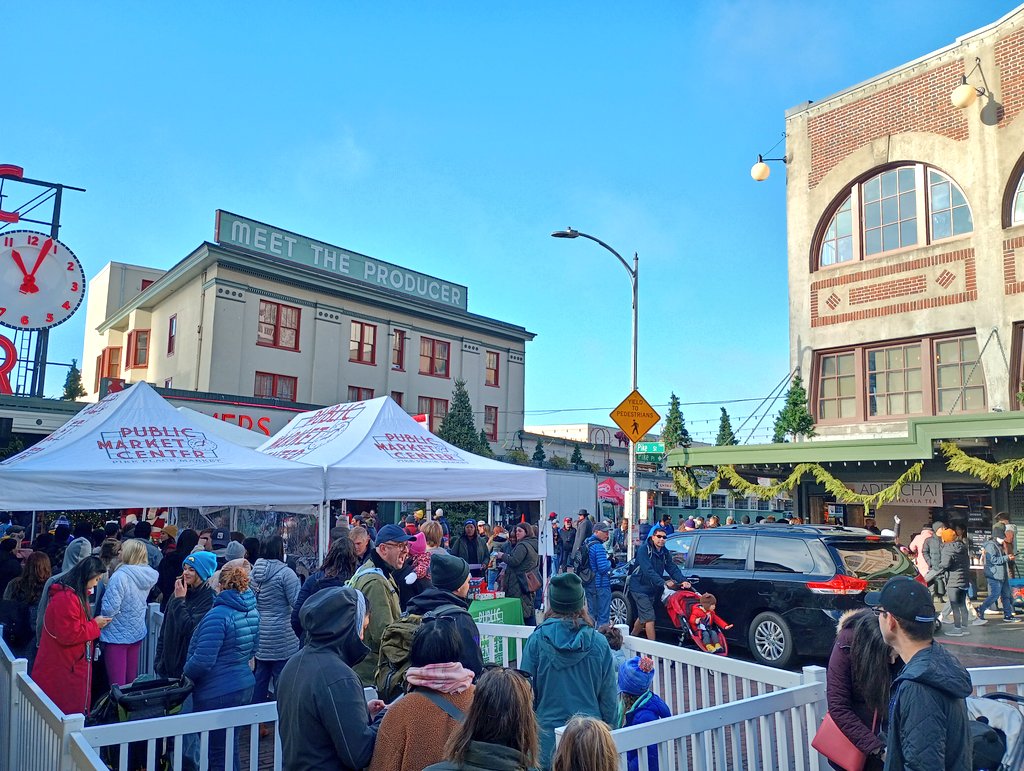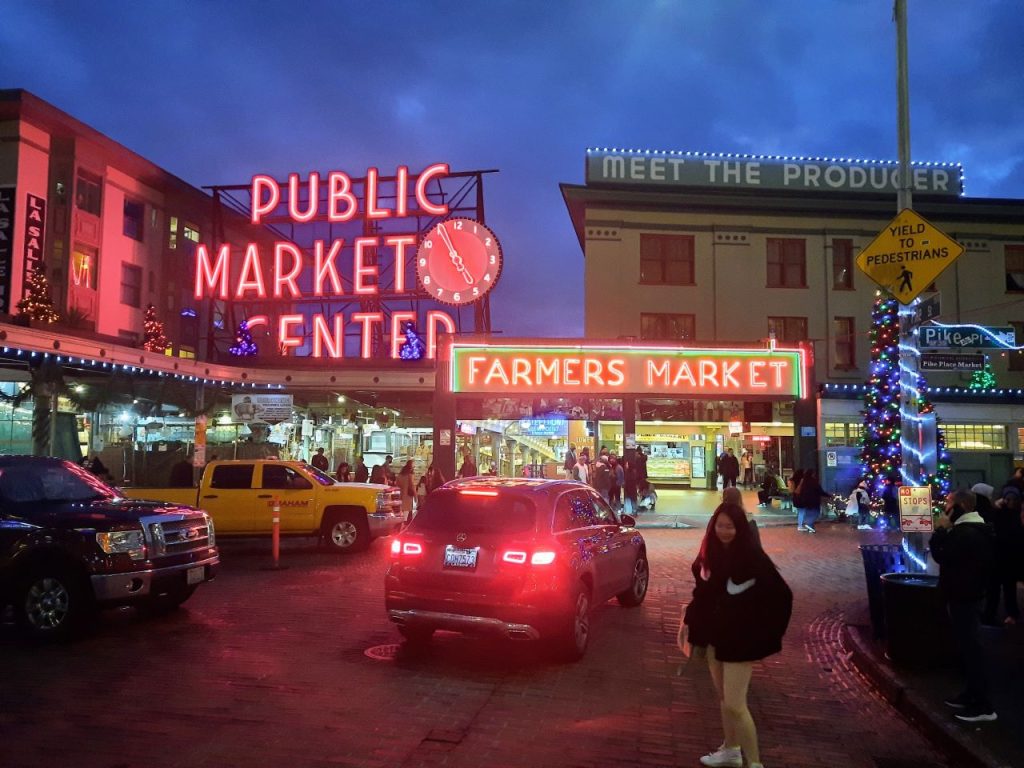
The largely symbolic move seeks to preserve Pike Place Market in amber and block funding for street changes.
The Seattle City Council is poised to adopt a sweeping, thousand-page transportation plan by the end of this month, dictating the direction of city policy for years to come and setting the stage for Seattle’s next transportation levy and the myriad decisions it will shape. But newly elected councilmember Bob Kettle is using an amendment to that plan to force a conversation about one of the most contentious stretches of roadway in the city — Pike Place.
The Seattle Transportation Plan (STP), released by the Harrell administration in its final form in February after two years of work, includes a long list of potential projects that the city could tackle over the coming years. Since the plan is the first transportation plan to actually acknowledge and potentially steward the way that Seattle uses streets in ways that aren’t entirely focused on moving from Point A to Point B, it includes a potential project along Pike Place, a natural fit for investments to create an “event street.”
Pike Place Market’s main corridor is a natural fit for improvements like this, since it already functions as an event street. The Pike Place Public Development Authority (PDA) which manages the Market on a day-to-day basis, already installs seating along the street in the summer months, closes the street for block-long or multi-block segments for special occasions, and permits vendors directly in the street itself. But the PDA has long pushed back on the idea of closing Pike Place to through traffic during the day, even during the Market’s busiest months, while still allowing full access to delivery vehicles.

The language in the plan around a Pike Place “event street” is incredibly vague, leaving much up for debate in the future. “This project prioritizes people walking and rolling around Pike Place while enabling efficient and reliable delivery of goods and access to Pike Place Market,” it reads. “This could include redesigning the street to make it more enjoyable for pedestrians and restricting access for people driving at certain times.”
But vague as it is, the event street designation has attracted the notice of some Market leaders who want the city to pull it out, arguing that they should be fully in the driver’s seat when it comes to any changes to Pike Place, including theoretical ones.
At the Market, the fight for full autonomy of decision-making is often lurking just below the surface of any other fight. “We don’t want you to take away the responsibility that the PDA and the [Market Historical Commission] and the Market community has for governance, and we want to maintain our control and management of Pike Street,” Devin McComb, chair of the PDA’s governing council told the city council’s transportation committee Tuesday. “It’s not an event street. It’s not a cafe street. It’s a market street. It has been since the Market was founded in that street in 1907.”
Fights against change are somewhat of a constant at Pike Place, a product of an incredibly intensive bureaucracy created to preserve almost all aspects of the Market as the city rapidly evolves and changes around it. Market leaders, including the non-profit group Friends of the Market, which was created in the mid-1960s to advocate against the Market’s planned demolition as part of an urban renewal project, have come out strongly in opposition to the Cultural Connector Streetcar. They argue the streetcar extension would choke off access to the Market’s front door even as it made it easier for people to visit the Market — not to mention restoring First Avenue to its original streetcar-hosting condition that existed when Pike Place Market was founded.
The Urbanist first pushed the idea of pedestrianizing Pike Place in 2015, but the idea has been slow to gain traction with Market management. Even a frightening 2022 road rage brawl that injured a pedestrian bystander has not shaken their resolve to keep things as they are.
Councilmember Kettle’s amendment doesn’t prohibit the Seattle Department of Transportation (SDOT) from spending levy funding on the Pike Place event street, and it doesn’t even remove it from the STP’s list of capital projects. It simply codifies a request to the Harrell administration that they not move forward with this project in the next transportation levy. “The Council anticipates that a proposal to renew the transportation levy will be presented to voters for the November 2024 election,” the amendment reads. “The Council anticipates that such a proposal will exclude funding for the Pike Place Event Street.”
On Tuesday, Kettle argued that the City should hold itself back from pursuing any potential changes to Pike Place, even as surveys of Market vendors suggest that support for pedestrianization may be deeper than Market leadership would like to admit. He argued that the street’s limitations were somehow geographic. “This is not William Penn’s Philadelphia, where we have nice squares going everywhere. [Pike Place] is on the cusp of falling into the sea,” Kettle said. “There’re no streets on the other side. There’s no First Avenue further west or Second Avenue further west. Basically, we have Elliott Bay.”

Kettle stated that he supports pedestrian streets — like the idea of creating a “campus environment” along 1st Avenue W in Upper Queen Anne — but questioned SDOT’s specific approach on Pike Place when the department hasn’t even laid out any approach at all yet.
“Good governance requires us to look at each project and proposal, and check in with the neighborhoods, check in with the stakeholders, and make sure that we make an objective decision based on unique circumstances and not decide with more of a cookie-cutter approach,” Kettle said.
Seattle Neighborhood Greenways, a strong advocate for moving forward with increased pedestrianization at the Market and elsewhere in the city, is already pushing back back on Kettle’s amendment this week with a letter-writing campaign, not only asking for the amendment to be pulled but for SDOT’s Pike Place event street to be fully funded in the levy. In less than 24 hours, the petition has already resulted in close to 6,000 letters sent to councilmembers.
“Please make the street a better experience for everyone — people walking, rolling, loading/unloading goods, and shopping, by restricting through-traffic and opening up opportunities such as more vendors, seating, art, music, or load zones,” the Seattle Neighborhood Greenways petition states. “Markets around the world have figured out how to do this while maintaining vendor loading/unloading, and we can too.”
No one argues that Pike Place Market isn’t a unique place with special challenges, or that any changes to how its main thoroughfare operates wouldn’t have to be carefully considered or include all of the Market stakeholders. But Kettle’s amendment puts front-and-center the idea that the broader city community shouldn’t have a chance to weigh in on what the future of the Market’s main corridor is. While it likely won’t directly have an impact on the city’s transportation funding decisions, it will send a strong signal that the city should butt out.
Take Action: Sign Seattle Neighborhood Greenways’ letter supporting pedestrianizing Pike Place and opposing the amendment.
Ryan Packer has been writing for The Urbanist since 2015, and currently reports full-time as Contributing Editor. Their beats are transportation, land use, public space, traffic safety, and obscure community meetings. Packer has also reported for other regional outlets including Capitol Hill Seattle, BikePortland, Seattle Met, and PubliCola. They live in the Capitol Hill neighborhood of Seattle.


